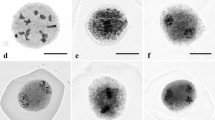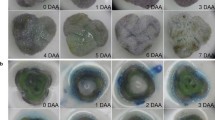Abstract
In this study, treatments of both trifluralin (at 10, 100 and 1000 μM) and N2O (in the form of gas under pressure) were applied to Begonia flower buds to induce the formation of 2n pollen. Three male fertile species (B. cucullata, B. subvillosa var. leptotricha and B. fischeri) and two male sterile hybrids (B. schmidtiana × B. cucullata and B. subvillosa var. leptotricha × B. cucullata) were treated. Pollen size, which is related to pollen DNA content, increased after both N2O and trifluralin treatments, but the induction of large pollen was genotype dependent. Trifluralin induced large pollen only in the male fertile species, while N2O treatments induced fertile 2n pollen in the male sterile B. schmidtiana × B. cucullata. Cytological studies showed that trifluralin induced multinuclear monads that resulted in 4n gametes in stead of 2n gametes. In general, large pollen obtained after trifluralin treatments showed low germination capability, while large pollen obtained after N2O treatments retained high germination capability. Seedlings with raised ploidy level could only be obtained after crosses were performed with large pollen obtained from N2O treatments. Hence, N2O treatments are preferable to the use of trifluralin to induce 2n gametes in Begonia.




Similar content being viewed by others
References
Akutsu M, Kitamura S, Toda R, Miyajima I, Okazaki K (2007) Production of 2n pollen of Asiatic hybrid lilies by nitrous oxide treatments. Euphytica 155:143–152
Anurita D, Girjesh K (2007) Morphogenetic analysis of colchitetraploids in Impatiens balsamina L. Caryologia 60:199–202
Barba-Gonzalez R, Miller CT, Ramanna MS, Van Tuyl JM (2006) Nitrous oxide N2O induces 2n gametes in sterile F1 hybrids of Oriental × Asiatic lilies (Lilium) and leads to intergenomic recombination. Euphytica 148:303–309
Bretagnolle F, Thompson JD (1995) Gametes with the somatic chromosome number: mechanisms of their formation and role in the evolution of autoploid plants. New Phytol 129:1–22
Brinkley BR, Rao PN (1973) Nitrous oxide: effects on the mitotic apparatus and chromosome movement in HeLa cells. J Cell Biol 58:96–106
Carputo D, Frusciante L, Peloquin SJ (2003) The role of 2n gametes and endosperm balance number in the origin and evolution of polyploids in the tuber-bearing Solanums. Genetics 163:287–294
Chen ZJ (2007) Genetic and epigenetic mechanisms for gene expression and phenotypic variation in plant polyploids. Annu Rev Plant Biol 58:377–406
Comai L (2005) The advantage and disadvantages of being polyploid. Nat Rev Genet 6:836–846
Contreras RN, Ranney TG, Tallury SP (2007) Reproductive behavior of diploid and allotetraploid Rhododendron L. ‘fragrant affinity’. HortScience 42:31–34
De Schepper S, Leus L, Mertens M, Debergh P, Van Bockstaele E, De Loose M (2001) Somatic polyploidy and its consequences for flower coloration and flower morphology in azalea. Plant Cell Rep 20:583–590
Dewitte A, Eeckhaut T, Van Huylenbroeck J, Van Bockstaele E (2009a) Occurrence of viable unreduced pollen in a Begonia collection. Euphytica 168:81–94
Dewitte A, Leus L, Vanstechelman I, Eeckhaut T, Van Huylenbroeck J, Van Bockstaele E (2009b) Genome size variation in Begonia. Genome 52:829–838
Dhooghe E, Grunewald W, Leus L, Van Labeke M-C (2009) In vitro polyploidisation of Helleborus species. Euphytica 165:89–95
Dover GA (1972) The organization and polarity of pollen mother cells of Triticum Aestivum. J Cell Sci 11:699–711
Dvorak J, Harvey BL, Coulman BE (1973) The use of nitrous oxide for producing eupolyploids and aneuploids in wheat and barley. Can J Genet Cytol 15:205–214
Eeckhaut T, Werbrouck S, Leus L, Van Bockstaele E, Debergh P (2004) Chemically induced polyploidization in Spathiphyllum wallisii Regel through somatic embryogenesis. Plant Cell Tissue Organ Cult 78:241–246
Hancock J (1997) The colchicine story. HortScience 32:1011–1012
Iizuka M, Ikeda A (1968) Induction of polyploidy in Lilium formosanum Wallace. Jpn J Genet 43:95–101
Jovtchev G, Schubert V, Meister A, Barow M, Schubert I (2006) Nuclear DNA content and nuclear and cell volume are positively correlated in angiosperms. Cytogenet Genome Res 114:77–82
Kato A (1999) Induction of bicellular pollen by trifluralin treatment and occurrence of triploids and aneuploids after fertilization in maize. Genome 42:154–157
Kato A (2002) Chromosome doubling of haploid maize seedling using nitrous oxide gas at the flower primordial stage. Plant Breed 121:370–377
Kato A, Birchler JA (2006) Induction of tetraploid derivates of maize inbred lines by nitrous oxide gas treatment. J Hered 97:39–44
Kehr AE (1996) Woody plant polyploidy. Am Nurserym 183:38–47
Kermani MJ, Sarasan V, Roberts AV, Yokoya K, Wentworth J, Sieber VK (2003) Oryzalin-induced chromosome doubling in Rosa and its effect on plant morphology and pollen viability. Theor Appl Genet 107:1195–1200
Kihara H, Tsunewaki K (1960) Production of polyploidy wheat by nitrous oxide. Proc Jpn Acad 36:658–663
Kitamura S, Akutsu M, Okazaki K (2008) Mechanisms of action of nitrous oxide gas applied as a polyploidizing agent during meiosis in lilies. Sex Plant Reprod 22:9–14
Kobayashi N, Yamashita S, Ohta K, Hosoki T (2008) Morphological characteristics and their inheritance in colchicines-induced Salvia polyploids. J Jpn Soc Hort Sci 77:186–191
Leitch I, Bennett M (1997) Polyploidy in angiosperms. Trends Plant Sci 2:470–476
Levin D (1983) Polyploidy and novelty in flowering plants. Am Nat 122:1–25
Lewis W (1980) Polyploidy in species populations. In: Lewis W (ed) Polyploidy: biological relevance. Plenum Press, New York, pp 103–144
Liu G, Li Z, Bao M (2007) Colchicine induced chromosome doubling in Platanus acerifolia and its effect on plant morphology. Euphytica 157:145–154
Lu C, Bridgen M (1997) Chromosome doubling and fertility study of Alstroemeria aurea × A. caryophyllaea. Euphytica 94:75–81
Murashige T, Skoog F (1962) A revised medium for rapid growth and bioassays with tobacco tissue cultures. Physiol Plant 15:473–497
Negri V, Lemmi G (1998) Effect of selection and temperature stress on the production of 2n gametes in Lotus tenuis. Plant Breed 117:345–349
Okazaki K, Kurimoto K, Miyajima I, Enami A, Mizuochi H, Matsumoto Y, Ohya H (2005) Induction of 2n pollen by arresting the meiotic process with nitrous oxide gas. Euphytica 143:101–114
Osborn T, Pires J, Birchler J, Auger D, Chen Z, Lee H, Comai L, Madlung A, Doerge R, Colot V, Martienssen R (2003) Understanding mechanisms of novel gene expression in polyploids. Trends Genet 19:141–147
Östergren G (1954) Polyploids and aneuplods of Crepis capilaris produced by treatment with nitrous oxide. Genetica 27:54–64
Otto SP, Whitton J (2000) Polyploid incidence and evolution. Annu Rev Genet 34:401–437
Planchais S, Glab N, Inzé D, Bergounioux C (2000) Chemical inhibitors: a tool for plant cell cycle studies. FEBS Lett 476:78–83
Ramanna MS, Jacobsen E (2003) Relevance of sexual polyploidization for crop improvement—a review. Euphytica 133:3–18
Robb L, Ladiges PY (1981) Morphological forms and polyploidy in Triglochin agg. in Victoria. Aust J Bot 29:639–651
Roberts A, Lloyd D, Short K (1990) In vitro procedures for the induction of tetraploidy in a diploid rose. Euphytica 49:33–38
Rose J, Kubba J, Tobutt K (2000a) Chromosome doubling in sterile Syringa vulgaris × S. pinnatifolia hybrids by in vitro culture of nodal explants. Plant Cell Tissue Organ Cult 63:127–132
Rose J, Kubba J, Tobutt K (2000b) Induction of tetraploidy in Buddleia globosa. Plant Cell Tissue Organ Cult 63:121–125
Soltis P, Soltis D (2000) The role of genetic and genomic attributes in the success of polyploids. PNAS 97:7051–7057
Stebbins G (1971) Chromosomal evolution of higher plants. Edward Arnold Ltd., London
Susin I, Álvarez JM (1997) Fertility and pollen tube growth in polyploidy melons (Cucumis melo L.). Euphytica 93:369–373
Takamura T, Miyajima I (1996) Colchicine induced tetraploids in yellow-flowered cyclamens and their characteristics. Sci Hort 65:305–312
Thompson JN, Nuismer SL, Merg K (2004) Plant polyploidy and the evolutionary ecology of plant/animal interactions. Biol J Linn Soc 82:511–519
Väinölä A (2000) Polyploidization and early screening of Rhododendron hybrids. Euphytica 112:239–244
Vaughn K, Lehnen L (1991) Mitotic disruptor herbicides. Weed Sci 39:450–457
Veilleux RE, Lauer FI (1981) Variation for 2n pollen production in clones of Solanum phureja Juz. and Buk. Theor Appl Genet 59:95–100
Wan Y, Duncan DR, Rayburn AL, Petolino JF, Widholm JM (1991) The use of antimicrotubule herbicides for the production of doubled haploid plants from anther-derived maize callus. Theor Appl Genet 81:205–211
Zlesak DC (2009) Pollen diameter and guard cell length as predictor of ploidy in diverse rose cultivars, species, and breeding lines. In: Zlesak DC (ed) Roses. Floricult ornament biotechnol, vol 3 (special issue 1). Global science books Ltd., UK, pp 53–70
Zlesak DC, Thill CA, Anderson NO (2005) Trifluralin-mediated polyploidization of Rosa chinensis minima (Sims) Voss seedlings. Euphytica 141:281–290
Acknowledgements
The authors want to thank the Institute for Agricultural and Fisheries Research (ILVO) and IWT-Flanders (project 40696) for their financial support.
Author information
Authors and Affiliations
Corresponding author
Rights and permissions
About this article
Cite this article
Dewitte, A., Eeckhaut, T., Van Huylenbroeck, J. et al. Induction of 2n pollen formation in Begonia by trifluralin and N2O treatments. Euphytica 171, 283–293 (2010). https://doi.org/10.1007/s10681-009-0060-z
Received:
Accepted:
Published:
Issue Date:
DOI: https://doi.org/10.1007/s10681-009-0060-z




